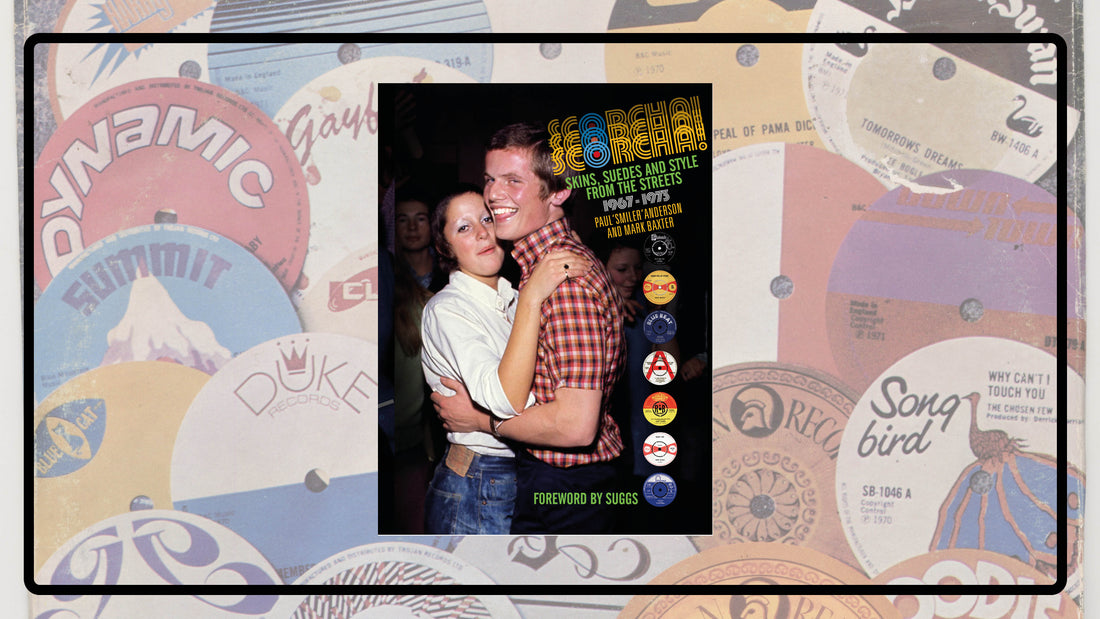
Scorcha! and Vinyl Labels
Share
Levis, Ben Sherman, Crombie, Reggae, rocksteady, soul. The look and sound of Suedeheads had a long-lasting impact on British style.
Scorcha!: Skins, Suedes and Style from the Streets 1967–73 by Paul 'Smiler' Anderson and Mark Baxter is a visual celebration of a fascinating period in post-war Britain. The cover of Scorcha! is designed by Paul McEvoy. In the centre of the cover, a pair of Suedeheads embrace and smile into the camera during a night at The Church of Ascension in Wemberley Park, circa 1970/1. To their right are seven vinyl labels from EPs, including 'How Long Will It Take' by Pat Kelly and 'Rough Rider' by Prince Buster & the All Stars. These seven labels parallel another of Smiler's books - Mods: The New Religion.
 Record labels are found throughout Scorcha! They document the Suedehead musical landscape of the late 60s and early 70s. Labels were a key part of the visual culture, like the clothes and haircuts. The vinyl labels were varied, with bright colours competing for attention, as shown by the eye-catching cover of the (recently reissued) 'Trojan Story' LP, a compilation album released originally in 1971. Rifling through record sleeves in a record shop created a kaleidoscope of colour, text and art.
Record labels are found throughout Scorcha! They document the Suedehead musical landscape of the late 60s and early 70s. Labels were a key part of the visual culture, like the clothes and haircuts. The vinyl labels were varied, with bright colours competing for attention, as shown by the eye-catching cover of the (recently reissued) 'Trojan Story' LP, a compilation album released originally in 1971. Rifling through record sleeves in a record shop created a kaleidoscope of colour, text and art.

Trojan Records have amongst the most iconic labels found in Scorcha! Their records feature the ancient 'Trojan' military helmet logo, often in white, orange or reddish brown. The helmet is a visual play on the nickname of Arthur 'Duke' Reid, who used a classic British Trojan truck as a sound system in Jamaica, stacked with radiogram sets and extra speakers. When Duke Reid drove his small but hardy van to evening dances in the Bond Street and Pink Lane area of Kingston, fans would shout 'Here comes the Trojan!' For the story of Trojan, check out Young, Gifted and Black.
Other iconic designs made more straightforwardly direct allusions to the company name, as with records put out by Bullet, a label which released reggae and soul tracks like 'Pupa Lie On Eye Top' by The Reggae Boys. Their labels feature a speeding bullet. Similarly, vinyl released by Crab Records have a red crab looming over the EP title, against a yellow background. Bright colours and simple designs on labels helped pull in the punters at record shops and made the vinyl recognisable. More or less militaristic art was popular on soul, reggae and rocksteady records from 1967 to 1971, with bullets, military helmets, explosions (Explosion Records), clenched fists (Punch Records) and cannons (Big Shot Records). This combination of bright colours and cartoonish violence played into the complicated relationship that reggae music had with peace, love, rebellion, violence and skinhead culture, themes which are explored in Scorcha!
More or less militaristic art was popular on soul, reggae and rocksteady records from 1967 to 1971, with bullets, military helmets, explosions (Explosion Records), clenched fists (Punch Records) and cannons (Big Shot Records). This combination of bright colours and cartoonish violence played into the complicated relationship that reggae music had with peace, love, rebellion, violence and skinhead culture, themes which are explored in Scorcha!
A particular favourite of mine are Invictus Records, a label founded by Eddie Holland and Lamont Dozier in Detroit, 1969. Brian and Eddie Holland tell the story of Invictus in Come and Get These Memories, published in 2019. Invictus vinyl feature a washed-out blue illustration of Rodin's famous 'Thinking Man' statue, with shards of blue and white shooting out of his head. This statue greeted visitors to the Detroit Institute of Arts. The statue and sophisticated composition reflected the ambitions of Eddie Holland the Invictus label at the time. 
For a deep dive into the music of Scorcha!, check out a playlist of top tracks put together by Mark Baxter:
The website of Excavated Shellac (https://excavatedshellac.com/) is a great resource for exploring vinyl label art from around the world.

1 comment
I absolutely love the Invictus label , Smiler and Bax`s book perfectly compliment The New Religion.
This book is as unputdownable as The New Religion, it captures a piece of time that lives on more in folklore than Mod which is known around the World.
Thank you for backing and publishing this book ,you will never know how anticipated it has been .